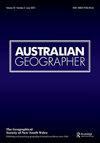Editorial introduction: counter-urbanisation in contemporary Australia: a review of current issues and events
IF 2
2区 社会学
Q2 GEOGRAPHY
引用次数: 4
Abstract
ABSTRACT ‘Counter-urbanisation’ has attracted international attention for decades, as an elusive concept that runs against the overwhelming trend of an urbanising world. In Australia, interest in counter-urbanisation waned after the peak interest from the 1970s until the early 2000s, however a recent resurgence of interest has grown due to anecdotal evidence of rising migration out of major cities. Advances in the ability to telecommute, the impacts of COVID-19 and lockdowns in major cities, and the impact of climate change on migration movements are some contemporary changes prompting the need for a renewed critical and theoretical analysis of counter-urbanisation. This editorial introduces the special issue that offers renewed insights to counter-urbanisation in Australia. We present three arguments to ground the elusive concept of ‘counter-urbanisation’ that underpins this special issue. We argue (1) that the contemporary examples of counter-urbanisation we are witnessing presently in Australia involve migration from major cities to regional spaces; (2) counter-urbanisation is determined by geographical context, in this case Australia and places within, and (3) Australian counter-urban movements are strongly linked to amenity and lifestyle migration. This editorial then introduces the special issue papers which together define and challenge the concept of counter-urbanisation within the Australian context.编辑简介:当代澳大利亚的反城市化:对当前问题和事件的回顾
摘要“反城市化”作为一个难以捉摸的概念,几十年来一直受到国际关注,它与城市化世界的压倒性趋势背道而驰。在澳大利亚,从20世纪70年代到21世纪初,人们对反城市化的兴趣达到顶峰后减弱了,但由于有传闻表明大城市的移民人数不断增加,最近人们的兴趣有所回升。远程办公能力的进步、新冠肺炎和大城市封锁的影响,以及气候变化对移民流动的影响,都是当代的一些变化,促使人们需要对反城市化进行新的批判性和理论分析。这篇社论介绍了一期特刊,为澳大利亚应对城市化提供了新的见解。我们提出了三个论点来支持这个特殊问题背后难以捉摸的“反城市化”概念。我们认为(1)我们目前在澳大利亚看到的反城市化的当代例子涉及从大城市向区域空间的迁移;(2) 反城市化是由地理环境决定的,在这种情况下,澳大利亚及其内的地方,以及(3)澳大利亚的反城市运动与舒适度和生活方式迁移密切相关。这篇社论随后介绍了特刊论文,这些论文共同定义并挑战了澳大利亚背景下的反城市化概念。
本文章由计算机程序翻译,如有差异,请以英文原文为准。
求助全文
约1分钟内获得全文
求助全文
来源期刊

Australian Geographer
GEOGRAPHY-
CiteScore
4.10
自引率
8.30%
发文量
33
期刊介绍:
Australian Geographer was founded in 1928 and is the nation"s oldest geographical journal. It is a high standard, refereed general geography journal covering all aspects of the discipline, both human and physical. While papers concerning any aspect of geography are considered for publication, the journal focuses primarily on two areas of research: •Australia and its world region, including developments, issues and policies in Australia, the western Pacific, the Indian Ocean, Asia and Antarctica. •Environmental studies, particularly the biophysical environment and human interaction with it.
 求助内容:
求助内容: 应助结果提醒方式:
应助结果提醒方式:


